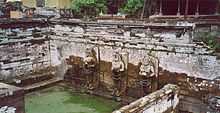Goa Gajah
From Wikipedia, the free encyclopedia

Entrance to the 'Elephant Cave'

Bathing temple

Bathing temple figures
Goa Gajah, or Elephant Cave, is located on the island of Bali near Ubud, in Indonesia. Built in the 9th century, it served as a sanctuary.[1]
Site description
At the façade of the cave is a relief of various menacing creatures and demons carved right into the rock at the cave entrance. The primary figure was once thought to be an elephant, hence the nickname Elephant Cave. The site is mentioned in the Javanese poem Desawarnana written in 1365. An extensive bathing place on the site was not excavated until the 1950s.[2] These appear to have been built to ward off evil spirits.
World Heritage Status
This site was added to the UNESCO World Heritage Tentative List on October 19, 1995 in the Cultural category.[3]
External links
 Central Bali travel guide from Wikivoyage
Central Bali travel guide from Wikivoyage
Notes
- ↑ Davison, J. et al. (2003)
- ↑ Pringle, R. (2004) p 61
- ↑ Elephant Cave - UNESCO World Heritage Centre
References
| Wikimedia Commons has media related to Goa Gajah. |
- Elephant Cave - UNESCO World Heritage Centre Accessed 2009-03-06.
- Pringle, Robert (2004). Bali: Indonesia's Hindu Realm; A short history of. Short History of Asia Series. Allen & Unwin. ISBN 1-86508-863-3.
- Davison, J.; Nengah Enu, Bruce Granquist, Luca Invernizzi Tettoni (2003). Introduction to Balinese Architecture. Tuttle Publishing. ISBN 0-7946-0071-9.
Coordinates: 8°31′24.20″S 115°17′10.89″E / 8.5233889°S 115.2863583°E
This article is issued from Wikipedia. The text is available under the Creative Commons Attribution/Share Alike; additional terms may apply for the media files.